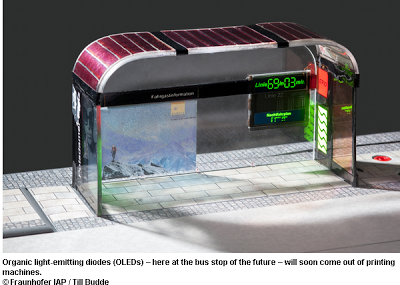Color-rich, energy-efficient, and flexible organic light-emitting diode (OLED) displays could soon be churned out more economically on giant inkjet printers. Mobile phone displays accounted for 71% of the US$4.9 billion 2012 OLED market. Within five years, it’s expected that more than half of all new phone displays will be OLED-based.
Other researchers area also making OLED based lights and solar cells. This thin film electronics has the potential to be low cost solar power, lights and displays.
OLED displays are widely expected to eventually supplant LCDs, the most common display today in TVs and computers. OLED displays use less power, have more vibrant colors, and can be made on plastic, making them attractive for flexible and even wearable electronics. The futuristic displays are already appearing in some expensive smartphones, digital cameras, and televisions. But manufacturing challenges have hindered attempts at mass production.
Kateeva has a movable platform that precisely positions glass panels or plastic sheets large enough for six 55-inch displays beneath custom print heads. Each print head contains hundreds of nozzles tuned to deposit picoliter-scale droplets in exact locations to build up the pixels of a display. The company says the tool can be incorporated fairly easily into existing display production lines.
Aiming to cut the cost of manufacturing flexible and large-size OLEDs, Kateeva today debuted YIELDjet™—an inkjet printing manufacturing equipment solution to produce such OLEDs in high volume. It’s the world’s first inkjet printer engineered from the ground up for OLED mass production. When compared to existing manufacturing technologies, YIELDjet will enable dramatic yield improvements, which, in turn, will drive production costs lower. This is made possible by these technical achievements:
1) YIELDjet is the only platform to feature a production-worthy pure nitrogen process chamber. Nitrogen is considered the gold-standard process environment for OLEDs, and an essential device lifetime enabler. YIELDjet doubles lifetime in certain applications;
2) YIELDjet reduces particles by as much as 10X—thanks to specialized mechanical design features. Such particle performance is a key yield accelerator;
3) YIELDjet offers exceptional film coating uniformity with a process window that’s 5X wider than standard technologies. This vastly improves process reliability and uptime.
When combined, these innovations offer display manufacturers a breakthrough solution to mass produce OLED devices more economically.
Lower cost OLED solar could extend the range of electric cars
A heavy electric pickup truck gets an extra 2 kilometers per hour of sunlight from solar power. A car that is 2-3 times lighter could get 4 kilometers per hour of sunlight. Lower cost production could make it worthwhile to use solar power to extend the range of cars and other vehicles. With enough efficiency range anxiety could be flipped around. The Solar powered electric car would have energy and would be able to move some distance whenever it was light out. A gasoline car would have no gas if there was no gas station nearby.
If you liked this article, please give it a quick review on ycombinator or StumbleUpon. Thanks

Brian Wang is a Futurist Thought Leader and a popular Science blogger with 1 million readers per month. His blog Nextbigfuture.com is ranked #1 Science News Blog. It covers many disruptive technology and trends including Space, Robotics, Artificial Intelligence, Medicine, Anti-aging Biotechnology, and Nanotechnology.
Known for identifying cutting edge technologies, he is currently a Co-Founder of a startup and fundraiser for high potential early-stage companies. He is the Head of Research for Allocations for deep technology investments and an Angel Investor at Space Angels.
A frequent speaker at corporations, he has been a TEDx speaker, a Singularity University speaker and guest at numerous interviews for radio and podcasts. He is open to public speaking and advising engagements.




